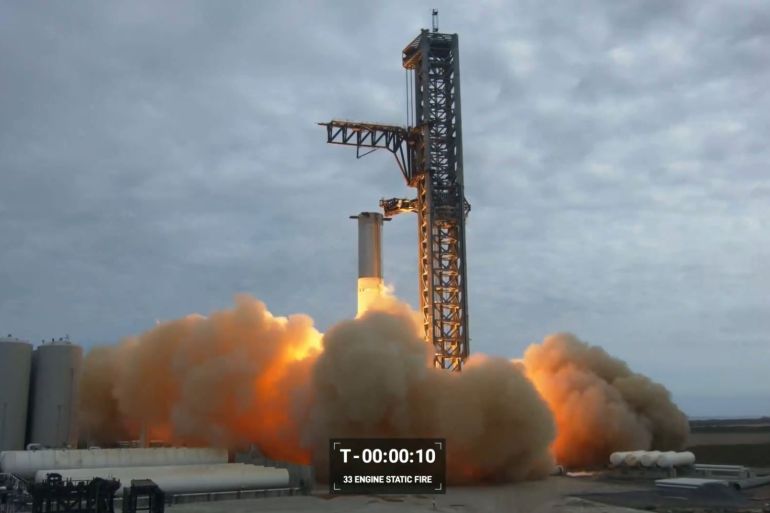SpaceX fires up giant Starship rocket engines in key test
The test of the Starship’s engines may have set a record for the most thrust ever produced by a single space rocket.

SpaceX has conducted a successful test-firing of the engines on the most powerful rocket ever built, designed to eventually send astronauts to the Moon and Mars.
The test on Thursday, called a static fire, of the 33 Raptor engines on the first-stage booster of SpaceX’s Starship took place at the private space company’s base in Texas and appeared to set a new record for the most thrust ever produced by a single space rocket.
Keep reading
list of 4 itemsSpaceX capsule brings four astronauts home from six-month mission
SpaceX to take tourist Dennis Tito on Starship around the Moon
Musk says SpaceX cannot fund Ukraine’s Starlink ‘indefinitely’
SpaceX founder Elon Musk said one engine was turned off just before the test began and one stopped itself.
“So 31 engines fired overall,” Musk said in a tweet. “But still enough engines to reach orbit!”
SpaceX said the test lasted its “full duration”.
Giant sheets of orange flames erupted from the base of the rocket and clouds of smoke billowed into the air during the test-firing, which lasted several seconds.
Views from drone of Booster 7's static fire test pic.twitter.com/KN4sk1nohf
— SpaceX (@SpaceX) February 9, 2023
NASA is counting on Starship to ferry astronauts to the surface of the Moon in a few years, linking up with its Orion capsule in lunar orbit. Further down the road, Musk wants to use the mammoth Starships to send people to Mars.
The 69-metre (230 ft) Super Heavy booster was anchored to the ground during the test-firing on Thursday to prevent it from lifting off.
Gwynne Shotwell, the president and chief operating officer of SpaceX, said at a conference in Washington, DC, on Wednesday that if the test was successful, the first orbital launch may take place within the next month or so. That launch, a test mission, would involve lifting off from Texas and landing off the coast of Hawaii.
“It’s really the final ground test that we can do before we light ’em up and go,” Shotwell said.
NASA has picked the Starship capsule to ferry its astronauts to the Moon as part of the Artemis 3 mission, set for 2025 at the earliest.
When mated to its upper-stage Starship spacecraft, the entire vehicle will stand taller than the Statue of Liberty at 120 metres (394 ft) high, forming the centrepiece of Musk’s ambitions to eventually colonise Mars. But plans call for it to first play a leading role in NASA’s renewed human exploration of the Moon.
Spaceflight enthusiasts lauded the engine test, describing it as “a big win” for SpaceX.
STATIC FIRE! Booster 7 fires up in a milestone test. We'll need SpaceX/Elon to confirm how many engines! But that looked super controlled, and everything appears intact (a big win!)https://t.co/kMGfaJbudD pic.twitter.com/kFb0m5DaJG
— Chris Bergin – NSF (@NASASpaceflight) February 9, 2023
SpaceX foresees eventually putting a Starship into orbit and then refuelling it with another Starship so it can continue a journey to Mars or beyond.
Other super heavy rockets under development include Blue Origin’s New Glenn, China’s Long March 9 and Russia’s Yenisei.
Blue Origin, the private space company founded by US tech billionaire Jeff Bezos, was awarded its first interplanetary NASA contract on Thursday to launch a mission next year to study the magnetic field around Mars, NASA said.
Plans call for Blue Origin’s recently developed New Glenn heavy-lift rocket to blast off with NASA’s dual-spacecraft ESCAPADE mission in late 2024 from the Cape Canaveral Space Force Station in Florida, the agency said.
New Glenn, with a reusable first stage designed to be flown on at least 25 missions, is named for pioneering NASA astronaut John Glenn, who became the first American to orbit Earth in 1962.
Blue Origin has flown previous NASA missions with its smaller, suborbital New Shepard rocket, which can carry research payloads on short, microgravity trips to the edge of space and back.